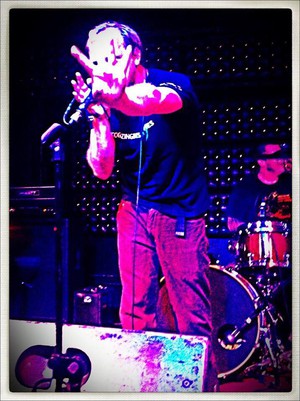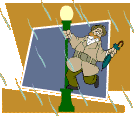“Do What Thou Wilt Shall be the Whole of the Law.”
I look forward to New York Comic Con every year. As a steady worker who rarely finds time for vacation, this is often the closest I get to relaxing over the past several years. I’ve been leaning more into unconventional invitations over the past few years, like sneaking off to see the stage show ‘The Shark is Broken,’ interviewing Max Brooks about Minecraft books, or speaking with David Dastmalchian about his newest graphic novel. I delight when I get an invitation that piques my interest for a property that I’d never even heard of before, and I get a few each year.
Cynthia Von Buhler’s MINKY WOODCOCK: THE GIRL CALLED CTHULHU is currently available from Hard Case Crime/Titan Comics. I was unfamiliar with the author, the title, and even the imprint when I got an invite to a NYCC afterparty aboard the Frying Pan Boat at Pier 66. An open bar, expansive food spread, and complementary black velvet capes? Of course I said yes.
The boat is an actual relic reclaimed from the sea, dredged from the bottom of the ocean and restored into a floating nightclub. The capes had all been claimed by the time I arrived but I enjoyed the gathering all the same. I found Cynthia Von Buhler holding court at the head of the boat, her head bearing horns and her own luxurious cape billowing to the ground. She offered me a reading from a single tarot card. I accepted, and she drew The Swords. I asked its orientation and her eyebrows rose. I said “It’s different if it’s upside down versus right side up, right?” She asked how I knew that, and I reminded her that it’s in her book. Apparently, my swords were in the direction that bodes well for me, though a change is coming for me, whether I want it or not.
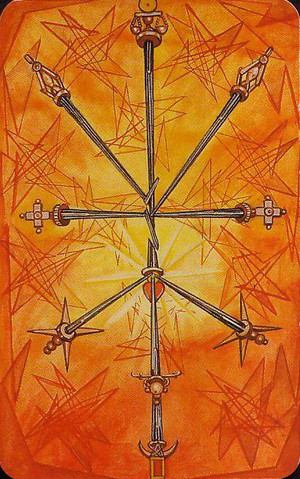
MINKY WOODCOCK: THE GIRL CALLED CTHULHU is, unbeknownst to me while reading it or interviewing Cynthia about it, the third collected adventure of its titular heroine. Before she was branded an eldritch horror, Miss Woodcock had also HANDCUFFED HOUDINI and ELECTRIFIED TESLA. Having not read those adventures, I only knew of her what I read, though I’ve learned since then that everything appears to be fairly surmised.
Minky Woodcock is, in my layman’s terms, sexy Forrest Gump. She traipses through history, buffing up against notable figures and inadvertently inspiring them to their greatest legacies. I offered this armchair Cliff Note to another partygoer aboard the Frying Pan and after a brief moment of reflection, he agreed. We both agreed, however, that it was quite reductive.
Minky Woodcock is singular, empowered, emboldened, and unbridled. Shouldering the weight of her listless actor brother and absent father, Minky embroils herself in the cases of Woodcock & Son Private Investigation. In this installment, she is visited by Aleister Crowley who asks for her help clearing his name from the slander of one Bettie May, who accuses the man of killing her husband. Minky’s investigation sends her straight to the hip of Gladys Michael, a new fast friend, as they confront the Tiger Woman, Bettie May. Dodging death, they encounter H.P. Lovecraft, Josephine Baker, Ian Fleming, and trigger-happy soldiers engaged in World War II derring-do.
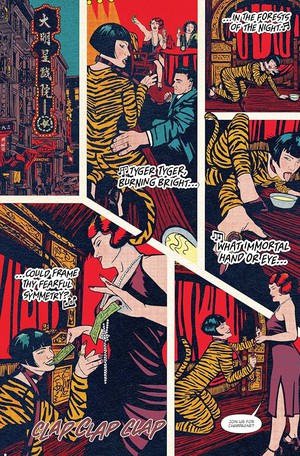
As the Frying Pan Boat party wrapped, I was invited to an afterparty at von Buhler’s loft. Another open bar and lively discussion of the art on the walls, many of which were her creations. Cynthia Von Buhler isn’t just the author of the Minky Woodcock series but also its principle illustrator. Her work is hand-painted and largely based around human models, most notably Pearls Daily as Minky Woodcock. The works presented in her loft apartment helped to deepen my appreciation for her artistic talents.
After too many drinks, we sat on von Buhler’s opium bed to discuss MINKY WOODCOCK: THE GIRL CALLED CTHULHU. This is typically when I would link the video interview below in a YouTube clip for you to enjoy… but we were both far too inebriated to allow that. You’ll have to settle for a cleaned-up transcription.
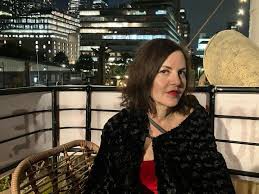
Eric McClanahan: So we’re talking about Minky Woodcock: The Girl Called Cthulhu. Where did the idea for this book come from?
Cynthia von Buhler: That’s an interesting question. Originally I wanted to do something about Ian Fleming and how he was a very interesting character. I thought about Minky working one of her cases and running into him while he was working for the government and coming up with all of these ideas for the British government on how to end World War II. So I was thinking in that direction and told the publisher and they said “oh…” because apparently Titan Comics had just taken on the entire Ian Fleming bibliography and were going to be doing graphic novels of his works. I don’t know if that panned out but that was the line, so they didn’t really want to do something else with Ian Fleming at the time. They said he could be in the book but he couldn’t be the primary focus, as I had envisioned. I even had a title in mind; something about Minky Breaking her Bonds or something like that.
EM: Some fun nod.
CvB: Something like that. I liked the idea of Minky being almost like a female James Bond and that Fleming would meet her and be inspired by her to come up with the James Bond character. Have you read the book yet?
EM: I have.
CvB: So you know that in the end, I kept all of that. She’s reading the book, THE BIRDS OF THE WEST INDIES, from which the actual name of James Bond comes. So I was told that the title couldn’t be about Fleming, so Nick, the head guy at Titan, said how about something on Lovecraft? Then his wife said how about something on Aleister Crowley? So we were having this meeting and they’re just throwing out names so I said okay, but I need to just go away for a year, do some research, and find this story. Because these people aren’t really related in any way and they’re even in different time periods. But the thing about Lovecraft and Crowley is that their work is so similar in a lot of ways. Their characters’ names are so similar so I thought it would be interesting if they had come into contact at some point. And maybe they did. That’s what I was researching. But the whole idea behind this book is, going back to Ian Fleming, that authors helped end World War II. In this story, I’ve got all these authors: Aleister Crowley, Ian Fleming, Basil Thompson - their ideas, their stories, helped to get this Operation: Mincemeat going and that tricked Hitler, and that’s what the whole book is about. How authors, creative people, came up with this idea that ended World War II. I don’t think that anyone’s ever done a book about that. There are so many books and movies about World War II but not the idea that authors had such a big part.
EM: So tell me about bringing some of these historical characters into the book and taking ownership over them, in terms of putting words in their mouths.
CvB: Well, a lot of the things that they say are things that they’ve actually said. I tried to use the way that they speak, their language, the things that I found in their books. I really did research that. Lovecraft was an interesting character. I didn’t know a lot about him when they mentioned him, though I knew about Aleister Crowley and a bit about Ian Fleming, but Lovecraft - I hadn’t really read all of his books. I mean, I knew about them, but I had to go and read them all, and he’s a wordy guy. He was really interesting, and the way he writes is really interesting, but he was also racist. He believed in genetic superiority, so he was kind of a Nazi. A sympathizer, at least, which a lot of people don’t like about him. I wanted to show that about him but also honor his work as a writer and creative person. There are a lot of monstrous men in this book, even Fleming is a bit of a womanizer. Aleister Crowley is funny; I think he’s a really funny character. I find him very interesting - he’s kind of evil, self-absorbed, narcissistic, but also kind of funny. There’s something funny about him, almost like he’s making fun of himself. So I took all of these people and showed them as I feel they would be if they met. If they all came into contact together, what would happen?
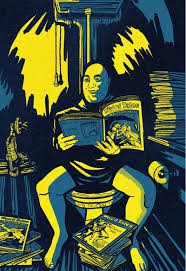
EM: I like that you have Aleister Crowley in this book because he is the ideal that hedonism is evil, but you also have your heroine, Minky Woodcock, who is also hedonistic in the way that she embraces the world. So tell me about how you try to draw the line between the evil and the hedonism.
CvB: Yeah, that’s true. She is a hedonist, but she’s a really kind person. She’s a very complicated person. She drinks too much. She kind of gets way too involved in all of her cases. She just gets in too deep, like with Houdini in THE GIRL WHO HANDCUFFED HOUDINI she just got really absorbed into his life; she just can’t help herself. I feel like she’s a good person though she’s definitely a little slutty, a little bit of trouble controlling her impulses, for sure. And he’s a hedonist. I had a band called the Woman of Sodom, so I’ve had [laughs] I’ve had my own history with these kinds of things, like sexual performances and stories, so it’s a part of me. I see that in Minky and Crowley. He is a really interesting character, just funny and weird, and I’m just trying to show that in the book. I think he’s kind of smart, but I don’t take him seriously. I think he’s kind of sarcastic. I don’t think he takes himself seriously. The whole thing about semen and death and you’re killing or sacrificing babies when you ejaculate? I think he was just playing with people, trying to get attention. He’s an attention monger, that’s what I see him as. I don’t really take him seriously as I just consider him a funny character. I know a lot of people think he’s scary and spooky and evil but I didn’t see him that way so I didn’t show him that way. He doesn’t scare me.
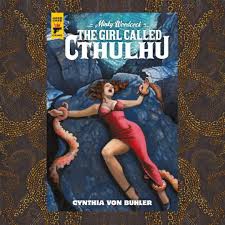
EM: I did have a question about the sexuality of the book. It seems to pair quite well alongside the other title at Hard Case Crime. Did you feel you had to elevate the sexuality in your books to fit the Hard Case Crime imprint or was that something that you felt mattered to the story and could only be published by such a daring label?
CvB: I’ve been friends with Charles [Ardai] of Hard Case Crime for many years. My husband introduced me to him. I’d been doing these crime stories. I was doing a play called “Speakeasy Dollhouse” about my grandfather who was murdered during prohibition and he owned speakeasies. Charles came to that and we talked about doing a book together but nothing was ever quite right. Then one day we were talking and I said that I had an idea; I really liked the idea of Houdini being into S&M because he always wants to be handcuffed and locked up and everything. That’s where this started with Hard Case Crime - I was just joking with Charles and said “the girl who handcuffed Houdini would be an interesting book” where it would have a private detective woman who is working a case with Houdini and gets too deep and they probably have an affair. The whole idea started it, that he got off being handcuffed and it was a sexual thing, so I did that one. Then, of course, they wanted me to do more like that, and that’s where the other books came in. Obviously, Tesla, the scientist and inventor, was not into sex at all. He’s totally sexless, so how do I make that? Luckily, Minky is very much a free spirit, that’s just part of her character. So, no, I didn’t do it for them. I just had this idea when Charles and I were talking and he liked it.
EM: Well, I think that’s all my questions. Thank you for talking to me.
CvB: Thank you.
MINKY WOODCOCK: THE GIRL WHO HANDCUFFED HOUDINI, THE GIRL WHO ELECTRIFIED TESLA, and THE GIRL CALLED CTHULHU are all available as collected graphic novels through Hard Case Crime / Titan Comics. If you like your noir with a bit of historical horror flair, you’ll be delighted by Minky Woodcock’s adventures and Cynthia von Buhler’s exhaustive research and lively illustration.
Until next time, take care.
-McEric, aka Eric McClanahan-